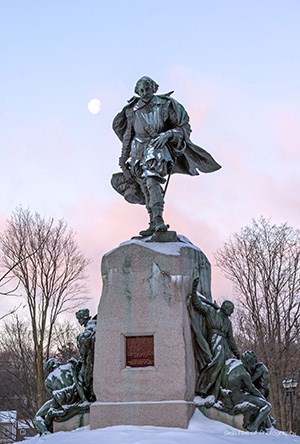In a fenced-off grassy area in the middle of Couchiching Beach Park sprouts a cement foundation on top of which is a newly-built staircase that, at least for now, provides steps to nowhere.
The site is where the Champlain Monument had stood since its unveiling in 1925. But last year, Parks Canada removed sculptor Vernon March’s work to be refurbished. It was to have been returned this spring.
“Today the new foundation and staircase have been installed on the site and the bronze sculptures have undergone restoration,” Jacqueline Soczka, the city’s manager of culture, told council committee Monday.
She noted “both Parks Canada and city staff have experienced a rise of inquiries, concerns and media attention concerning the monument … since the restoration project began.”
As a result, Parks Canada, the owner of the monument, has put the brakes on the project pending further consultation about its future.
According to Soczka, that consultation is meant “to ensure that we look at a path forward for the monument that is both respectful and representative of the city’s shared history with Indigenous and non-Indigenous people.”
The working group will include representatives of Orillia City Council, Parks Canada, the Elementary Teachers Federation of Ontario, the Chippewas of Rama First Nation, the Huron Wendat Nation and members of the public.
“Parks Canada will work with stakeholders to develop a terms of reference,” noted a report presented to council committee. “The Manager of Culture from the City of Orillia and staff from Parks Canada will provide administrative support in the areas of secretariat, public engagement, advice with respect to policy, and practical implications of various options.”
Orillia Mayor Steve Clarke acknowledged Monday there is a “sensitivity” around the monument.
“This is a sensitive issue and in light of other situations (in the U.S. and Canada) there is a sensitivity around this,” said Clarke. “In the true spirit of truth and reconciliation, it’s something that has to be handled properly.”
He noted talks were already ongoing prior to Parks Canada’s decision to temporarily remove the statue for restoration work.
He said retired local elementary school history teacher Michael Shilolo and the Elementary Teachers Federation of Ontario had been developing a potential “interpretive piece down at the park.”
“They saw the monument as a depiction of history (and) some of the interpretive pieces around the monument do not tell the whole story or the accurate story of our First Nations past or our Indigenous past, so their desire was to work with the city to come up with some different interpretive pieces that would work in conjunction with the Champlain Monument.”
The mayor said he doesn’t believe the Orillia scenario is akin to others such as in Victoria, B.C. where a decision was made in recent weeks to remove a John A. Macdonald statue.
“Champlain’s involvement with our Indigenous folks in the past was a good relationship and wasn’t associated with some of the other issues that have plagued other municipalities,” said Clarke. “I’m hoping it’s a different situation here.”
Council committee, whose decision must be ratified Thursday, voted to appoint Coun. Tim Lauer to the working group.
Coun. Ralph Cipolla said he thought the mayor should be the city’s representative but council, ultimately chose Lauer.
Lauer, who said he would be happy to step aside should the mayor want the job, noted he does have some experience that might be helpful.
“I do have considerable experience working in this area with the Mnjikaning Fish Fence Circle and, of course, the ongoing project at The Narrows is a commemoration of an Indigenous site that predates the Champlain Monument by about 3,000 years,” said Lauer.
There was also discussion about the merit of appointing someone now in light of the looming municipal election in the fall.
However, Parks Canada is “looking for some sort of direction by the spring of 2019,” so staff recommended council make a decision this week.
THE HISTORY
The Champlain Monument is located within Orillia’s Couchiching Beach Park on a parcel of land owned and maintained by the federal government.
Charles Harold Hale, publisher of the Orillia Packet newspaper and community advocate, first proposed the idea of a monument to officers of the Orillia Canadian Club following a trip to Quebec and St. John, New Brunswick.
Both cities have monuments to Champlain due to their connection to the explorer. Orillia was the nearest settlement to Cahiague, where Champlain wintered in 1615 with the Huron Wendat Nation.
The monument includes a 12-foot bronze sculpture of Champlain dressed for court along with two sculpture groups representing Christianity and Commerce.
An inscription on the monument states that it was erected to commemorate the advent into Ontario of the white race, and as a symbol of goodwill between the French- and English-speaking people of Canada.
It was created by Vernon March of Farnborough, Kent, England, and commissioned to mark the 300th anniversary of the French explorer’s arrival to the region. However, work on the monument was delayed due to the First World War. The sculpture was unveiled a decade later on July 1, 1925, in front of roughly 10,000 spectators.
The monument was budgeted to cost $20,000. However, the delay added $14,000 to the project. Contributors included the Dominion (federal) Government ($12,500), the Ontario Government ($5,000), the Government of Quebec ($5,000), Orillia Town Council ($1,500) and Simcoe County ($1,000), along with private donors.
At its meeting held on March 4, 1955, Council passed a motion to transfer ownership of the Champlain Monument and surrounding ten-foot-by-ten-foot parcel of land (measured from the base of the steps) to the Department of Northern Affairs and National Resources (DNANR). Previous correspondence from the DNANR indicates that the Department agreed to take over custody and maintenance of the monument in connection with their historic sites work.
The Deed of Land was registered in the name of Her Majesty the Queen in Right of Canada on July 6, 1971.
